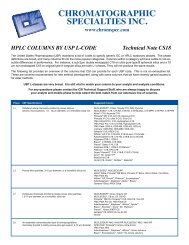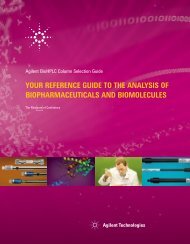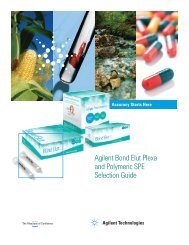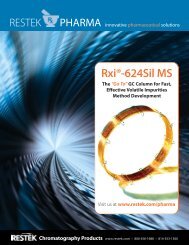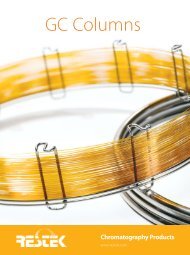Optimizing the Analysis of Volatile Organic Compounds
Optimizing the Analysis of Volatile Organic Compounds
Optimizing the Analysis of Volatile Organic Compounds
You also want an ePaper? Increase the reach of your titles
YUMPU automatically turns print PDFs into web optimized ePapers that Google loves.
48<br />
www.restekcorp.com<br />
Many state methods, such as <strong>the</strong> Massachusetts <strong>Volatile</strong> Petroleum Hydrocarbon (VPH)<br />
method, require resolution <strong>of</strong> <strong>the</strong> oxygenates and <strong>the</strong> early eluting alkanes, such as<br />
2-methylpentane and 3-methylpentane (Figure 45). The most common column used for<br />
GRO analysis is a 30m, 0.53mm ID column with a 1.5µm df film <strong>of</strong> 5% diphenylpolysiloxane<br />
phase, such as Rtx ® -5. These columns resolve <strong>the</strong> difficult compounds chlorobenzene<br />
and ethylbenzene from <strong>the</strong> xylenes. An Rtx ® -502.2 column performs this separation equally<br />
well, but a longer column is needed.<br />
PID<br />
Figure 45.<br />
For VPH analysis on an Rtx ® -502.2 column, use PID for aromatic<br />
compounds and FID for aliphatic compounds<br />
1<br />
4<br />
6<br />
min. 4 8 12 16 20 24 28 32<br />
FID<br />
1<br />
2<br />
3<br />
4<br />
min. 4 8 12 16<br />
GC_EV00063<br />
20 24 28 32<br />
105m, 0.53mm ID, 3.0 m Rtxfi-502.2 (cat.# 10910).<br />
Concentration: on-column at levels listed<br />
Oven temp: 45 C to 90 C @ 3 C/min., to 140 @ 5 C/min.,<br />
to 230 C @ 45 C/min. (hold 8 min.)<br />
Carrier gas: helium @ 15mL/min. Tekmarfi Model LSC 2000<br />
Trap: BTEX<br />
Purge: helium @ 40mL/min. for 11 min.<br />
Dry purge: 2 min.<br />
Desorb preheat: 245 C<br />
Desorb: 2 min. @ 250 C<br />
Bake: 6 min. @ 260 C<br />
Chromatograms courtesy <strong>of</strong> Severn Trent Laboratories, Burlington, VT.<br />
5<br />
6<br />
7<br />
7<br />
9<br />
8 9<br />
10<br />
10<br />
11<br />
11<br />
12<br />
12<br />
13<br />
13<br />
14<br />
14<br />
1. methanol<br />
2. n-pentane (40ng)<br />
3. 2-methylpentane (60ng)<br />
4. methyl tert-butyl e<strong>the</strong>r (60ng)<br />
5. 2,2,4-trimethylpentane (60ng)<br />
6. benzene (20ng)<br />
7. toluene<br />
8. n-nonane<br />
9. ethylbenzene (20ng)<br />
10. p+m-xylene (40ng ea.)<br />
11. o-xylene (40ng)<br />
12. 1,2,4-trimethylbenzene (40ng)<br />
13. naphthalene (40ng)<br />
14. 2,5-dibromotoluene (SS)





